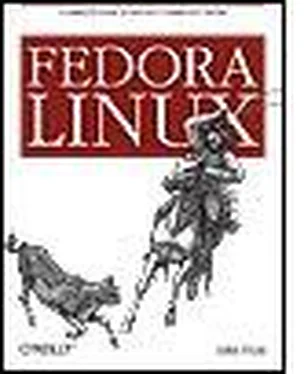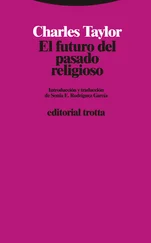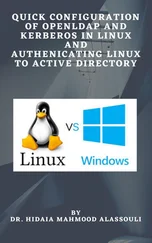O'Reilly Media, Inc.
1005 Gravenstein Highway North
Sebastopol, CA 95472
800-998-9938 (in the United States or Canada)
707-829-0515 (international or local)
707-829-0104 (fax)
There is a web page for this book, which lists errata, examples, and any additional information. You can access this page at:
http://www.oreilly.com/catalog/fedoralinux
To comment on or ask technical questions about this book, send email to:
bookquestions@oreilly.com
For more information about books, conferences, software, Resource Centers, and the O'Reilly Network, see the O'Reilly web site at:
http://www.oreilly.com
Thank you to the open source community and to Red Hat and the Fedora community in particular for developing, integrating, and supporting such a powerful collection of software.
I'd like to thank my editor, Brian Jepson, for his patient and skillful work and many suggestions; to David Brickner for getting me started on this project; and to Behdad Esfahbod for his thoughtful and detailed technical review.
My deep gratitude to my loving wife Diane and my girls Saralyn and Laura, who have patiently kept the family going without me for the past eight months. And above all, my humble thanks to God for the skills and understanding he has given memay they be used to His glory.
Chapter 1. Quick Start: Installing Fedora
Fedora is a powerful, fast-changing, freely available operating system. It can be used as a productive desktop or server environment, or it can be used to learn about Linux and experiment with new technologies.
1.1. Choosing Fedora: Is It Right for You?
There are many different Linux distributions, each with a different set of features, aimed at a different type of user. Before you invest time and effort in Linux, you need to decide if Fedora is the right distribution for you.
Fedora Core is a collection of software that provides a complete working environment for a desktop or a server computer. It is often called an operating system , but, like other Linux distributions, it provides a lot more functionality than operating systems such as Microsoft Windows or Mac OS X because it includes desktop productivity applications and server software. Fedora Extras is a collection of software that is compatible with and extends the functionality of Fedora Core.
Fedora is developed and supported by a large community of developers, testers, package maintainers, documentation writers, marketers, and advocates. Many leading community members are also employees of Red Hat, Inc., which provides servers, build systems (the computers that compile and test the thousands of packages included with Fedora) and some funding for the project. In return, Red Hat gains the opportunity to receive feedback on new software and features before incorporating them into its commercial product line, called Red Hat Enterprise Linux.
1.1.1.1. What compatibility do you need?
If you want (or need) to run Windows games or a specific Windows application, Fedora may not be the right OS for youalthough Wine will let you run some Windows applications when you're in a pinch. Two commercial products based on Wine are available: Cedega, for Windows games, and CrossOver Office, for Microsoft Office and other business applications.
1.1.1.2. What level of stability do you need?
A new Fedora release is made approximately every four to nine months, and only the current and next-to-current releases are actively maintained by the project (beyond this time frame, security and bug fixes are supplied by the Fedora Legacy project).
If you need a platform with long-term stability, consider using Red Hat Enterprise Linux (RHEL) instead (or CentOS, which is a nonaffiliated project based on RHEL that does not have commercial support). Each RHEL release is supported with updates and security enhancements for a full seven years.
Because Fedora serves as a testbed for new technologies, it can be used to gain a preview of the new technologies that will be incorporated into future Red Hat Enterprise Linux releases.
1.1.1.3. What kind of support do you need?
As a community distribution, support for Fedora is provided by the Fedora community rather than a commercial entity. That means that most questions receive a quick and friendly answer, but since no one is being paid to help you, you may not receive any answers to unique or unusual questions.
If you like Fedora but need commercial support, consider using RHEL, which is Red Hat's fully supported commercial Linux product.
1.1.1.4. Does your equipment meet Fedora's system requirements?
Fedora will install on PCs with Intel and AMD 32- and 64-bit processors, as well as compatible processors from Transmeta, Via, and others. You will need a minimum of 256 MB of memory, 7 GB of disk space, and a processor speed of 400 MHz to obtain reasonable performance with the graphical user interface. A broadband Internet connection is desirable for obtaining software updates but is not necessary.
You can install a very basic version of Fedora Core without a graphical user interface on a system with as little as 64 MB of memory, 1 GB of disk space, and a processor speed of 200 MHz. However, this is not recommended for desktop usage.
You can also install Fedora Core on a system with a PowerPC processor, such as an Apple Mac produced after 1999 and before 2006, or an IBM RS/6000 system.
Fedora Core includes over 2,200 software packages, and Fedora Extras (a library of compatible software) includes hundreds more. All of these packages are open source ( http://www.opensource.org/ ), which means that the human-readable version of the software ( source code ) is distributed along with the ready-to-run binaries . Each package is licensed under one of a set of open source licenses that permits the software to be modified, adapted, and redistributed.
Most of these packages are developed and maintained by a team that may include developers, documentation writers, and testers, and most of the packages are not specific to Fedora; they're also distributed with other Linux distributions and non-Linux operating systems (for example, the excellent Firefox web browser is used on Linux, Windows, Mac OS X, and many other operating systems).
Each of these pieces of software is packaged for Fedora by another maintainer. To distinguish the two groups, the original developers and maintainers of the software are called the upstream maintainers , while the people responsible for integrating the package into Fedora are called Fedora maintainer s. The Fedora packages use the RPM package format for ease of management by package tools such as yum .
The current development version of Fedora is called Rawhide (see Lab 9.4, "Running Rawhide ") and is highly unstable; people using Rawhide expect a steady flow of changes, along with features that appear and disappear, and work and then stop working again. Rawhide serves as the testing and proving ground for the software that will become the next Fedora release.
A similar process is used for Fedora Core updates and Fedora Extras: software is released to a testing repository, where it is tested by volunteers on the bleeding edge, and once the bugs are worked out, the software is moved to the Fedora Core updates or Fedora Extras repository.
1.1.3.1. ...trying Fedora but also keeping Windows?
Читать дальше












